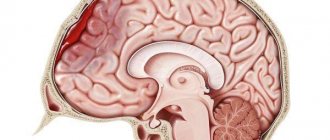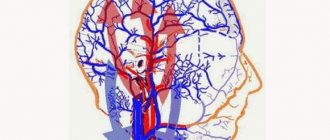Information about other types of diseases starting with the letter “V”: Vegetative state, Ventricularity, Vestibular ataxia, Vestibular neuronitis, Vibration disease, Viral meningitis, Viral encephalitis, Temporal lobe epilepsy, Intracerebral hematoma, Intracranial tumors of the cerebral hemispheres, Intracranial hypertension, Inflammatory myopathy, Inflammatory polyneuropathy , Congenital myopathy, Congenital paramyotonia, Secondary parkinsonism
In the medical community, the syndrome of increased intracranial pressure is called intracranial hypertension or hypertension. This disease develops against the background of damage to the brain tissue or appears autonomously, due to factors independent of the body.
Hypertension is a polysyndromic disease, and its manifestations are diverse: severe headaches with a feeling of pressure on the eyes, sometimes with temporary distortion of visual fields, a feeling of lightheadedness and vomiting. When blood pressure rises to high levels, loss of consciousness is possible.
The diagnosis is based on clinical manifestations, head tomography data, and echoEG results. An analysis of spinal fluid and ultrasound of brain vessels may also be necessary. Due to the large number of syndromes, treatment consists of eliminating or alleviating them. Neurosurgical operations are indicated in special circumstances.
Types of disease
Intracranial hypertension (ICP) is a disease that often occurs not only in adults, but also in children. The measure of intracranial pressure corresponds to the height of pressure in the spinal cord fluid, which is why this disease is also called cerebrospinal fluid hypertension syndrome. After head injuries or during brain diseases, hypertension is of a secondary nature. In a larger number of patients, hypertension is primary and manifests itself without visible motives - idiopathic hypertension, which is defined according to the ICD-10 classifier as benign. This diagnosis is established by a differential method of eliminating all possible causes of increased pressure inside the head.
ICP is divided into acute and chronic. The acute form occurs against the background of traumatic brain injury or infection, the chronic form occurs when vascular problems or intracerebral formations (tumors, cysts) occur. Chronic hypertension can be a side effect after brain surgery or after strokes, infections, or injuries.
Diagnostics
If increased intracranial pressure is suspected, a number of additional examinations are necessary, in addition to the standard collection of complaints, medical history and neurological examination. First of all, the patient is referred to an ophthalmologist, who will examine the fundus of the eye. X-rays of the skull bones are also prescribed. More informative examination methods are computed tomography and magnetic resonance imaging, since they allow us to examine not only the bone structures of the skull, but also the brain tissue itself. They are aimed at finding the immediate cause of increased intracranial pressure.
Previously, to directly measure intracranial pressure, a spinal tap was performed and the pressure was measured using a pressure gauge. Currently, performing a puncture with the sole purpose of measuring intracranial pressure in diagnostic terms is considered inappropriate.
Etiology and pathogenesis of intracranial hypertension
The sources of the disease are divided into groups:
The first is brain formations - primary or metastatic tumors, cysts, cerebral aneurysms, hematomas.- The second progresses against the background of a head injury, oxygen deficiency, ischemic stroke, toxic effects, encephalitis, edema of the brain or its membranes.
A separate group includes vascular causes that cause increased filling of the brain vessels with blood. This is possible when the temperature rises, when there is an excess of carbon dioxide in the blood, or when venous circulation is impaired.
Liquorodynamic disorders were identified as a separate category of causes of cerebral hypertension. It is caused by an increase in the production of cerebrospinal fluid. In this case, the volume of cerebrospinal fluid becomes excessive and leads to hydrocephalus.
Benign ICP occurs for unclear reasons. It develops more often in women than in men due to weight gain. This pattern gave rise to the hypothesis of an endocrine cause of the disease. Hypertension is caused by excessive intake of vitamin A, taking certain medications, and withdrawal of corticosteroid hormones after long-term use.
The skull is a confined cavity, so growing parts of the brain causes increased pressure. The result of this is compression of the brain of varying degrees. This condition leads to dysmetabolic changes in brain neurons. The more pressure increases, the more significant the shifting of brain structures, which can lead to wedging of the cerebellar tonsils into the foramen magnum. The cardiovascular and respiratory nerve centers are located in the brain stem, and when compression of these areas occurs, the vital functions of the body are disrupted.
The occurrence and development of the disease in children is facilitated by malformations of the brain (hydrocephalus, microcephaly, defects in the development of arteries and veins of the brain), birth injuries to the head, intrauterine infections, asphyxia and hypoxia of newborns. Due to the mobility of cranial sutures and their elasticity in infancy, the manifestations of high ICP contribute to long-term compensation.
General characteristics of the pathology
Benign, or idiopathic, intracranial hypertension is not an independent diagnosis. This is a condition that is caused by certain unfavorable factors that are temporary.
Most often, pseudotumor cerebri is detected in women who are overweight, as well as in children with iron deficiency anemia. The overall prevalence of this pathology is 6% among all cases of intracranial hypertension.
The syndrome is characterized by an increase in cerebrospinal fluid pressure, due to which the latter cannot circulate freely and accumulates between the ventricles and the membranes of the brain.
The distinctive features of this condition are:
- relative ease of flow;
- no risk of developing dangerous and serious complications;
- the absence of such manifestations characteristic of hypertension as impaired consciousness and decreased ability to work.
Idiopathic intracranial hypertension occurs abruptly: it is usually not preceded by specific precipitating events.
Clinical signs of pathology
The main symptom of the disease is headache. A growing, intense headache is a sign of an acute attack of hypertension. Intermittent headaches are a sign of a chronic form of the disease. The pain is symmetrical, with a feeling of pressure on the eyes, localized in the frontal and parietal parts of the head.
Patients report nausea, vomiting, pain when moving their eyes, and a feeling of fullness in the head. An acute, growing headache leads to loss of consciousness, and in severe cases to coma. Long-term hypertension worsens the general nervous condition of the patient, causing physical fatigue, nervousness, sleep disturbances, and mental instability.
Chronic intracranial hypertension lasts with crises - periods of sudden surges in pressure with severe headaches, nausea, vomiting, and fainting. Most often, patients experience darkening of the eyes, deterioration of sharpness, or double vision. 30% of patients note a decrease in vision clarity.
Intracranial hypertension in children under one year of age is accompanied by refusal of mother's milk, crying and restlessness, frequent regurgitation, and tension of the fontanel. Chronic hypertension in an infant can cause mental retardation, even mental retardation.
Symptoms
An increase in intracranial pressure leads to compression of nerve cells, which affects their function. Regardless of the cause, intracranial hypertension syndrome manifests itself:
- bursting diffuse headache. The headache is more pronounced in the second half of the night and in the morning (since the outflow of fluid from the cranial cavity worsens at night), is dull in nature, and is accompanied by a feeling of pressure on the eyes from the inside. The pain intensifies with coughing, sneezing, straining, physical stress, and may be accompanied by noise in the head and dizziness. With a slight increase in intracranial pressure, you may simply feel a heaviness in the head;
- sudden nausea and vomiting. “Sudden” means that neither nausea nor vomiting is provoked by any external factors. Most often, vomiting occurs at the height of the headache, during its peak. Of course, such nausea and vomiting are completely unrelated to food intake. Sometimes vomiting occurs on an empty stomach immediately after waking up. In some cases, vomiting is very strong, fountain-like. After vomiting, a person may experience relief, and the intensity of the headache decreases;
- increased fatigue, rapid exhaustion both during mental and physical exertion. All this may be accompanied by unmotivated nervousness, emotional instability, irritability and tearfulness;
- weather sensitivity. Patients with intracranial hypertension do not tolerate changes in atmospheric pressure (especially its decrease, which happens before rainy weather). Most symptoms of intracranial hypertension intensify at these moments;
- disturbances in the functioning of the autonomic nervous system. This is manifested by increased sweating, changes in blood pressure, and a feeling of palpitations;
- visual impairment. Changes develop gradually, being transitory at first. Patients note the appearance of periodic blurriness, as if blurred vision, sometimes double images of objects. Movement of the eyeballs is often painful in all directions.
The duration of existence of the symptoms described above, their variability, and the tendency to decrease or increase are largely determined by the main cause of intracranial hypertension. The increase in the phenomena of intracranial hypertension is accompanied by an increase in all signs. In particular, this may manifest itself:
- persistent daily morning vomiting against a background of severe headache for the whole day (and not just at night and in the morning). Vomiting may be accompanied by persistent hiccups, which is a very unfavorable symptom (it may indicate the presence of a tumor in the posterior cranial fossa and signal the need for immediate medical attention);
- increasing depression of mental functions (appearance of lethargy, up to disturbance of consciousness such as stupor, stupor and even coma);
- increased blood pressure along with depression (decreased breathing) and slowed heart rate to less than 60 beats per minute;
- the appearance of generalized seizures.
If such symptoms appear, you must immediately seek medical help, since all of them pose an immediate threat to the patient’s life. They indicate an increase in the phenomena of cerebral edema, in which it can be pinched, which can lead to death.
With the long-term existence of the phenomena of intracranial hypertension, with the gradual progression of the process, visual impairment becomes not episodic, but permanent. A great diagnostic aid in such cases is an examination of the fundus by an ophthalmologist. In the fundus of the eye, ophthalmoscopy reveals congestive optic discs (essentially their swelling); small hemorrhages in their area are possible. If the phenomena of intracranial hypertension are quite significant and exist for a long time, then gradually the congestive discs of the optic nerves are replaced by their secondary atrophy. In this case, visual acuity is impaired, and it becomes impossible to correct it with lenses. Optic nerve atrophy can result in complete blindness.
With the long-term existence of persistent intracranial hypertension, distension from the inside leads to the formation of even bone changes. The plates of the skull bones become thinner, the back of the sella turcica is destroyed. The convolutions of the brain seem to be imprinted on the inner surface of the bones of the cranial vault (this is usually described as increased digital impressions). All these signs are detected during a simple x-ray of the skull.
A neurological examination in the presence of symptoms of increased intracranial pressure may not reveal any abnormalities at all. Occasionally (and even when the process persists for a long time), one can detect a limitation in the abduction of the eyeballs to the sides, changes in reflexes, a pathological Babinski sign, and impaired cognitive functions. However, all these changes are nonspecific, that is, they cannot indicate the presence of intracranial hypertension.
Establishing diagnosis
Only a neurologist, after thorough examinations, can make a diagnosis of high intracranial pressure. The main difficulty is that there is no generally accepted standard for ICP indicators. The experience of many years of research allows us to conclude that pressure values from 70 to 220 mm of water can be considered normal. pillar
Papilledema detected by an ophthalmologist may be a sign of ICP. X-rays of his skull show areas of thinning of his bones. A successful diagnostic method was lumbar puncture. When a needle is inserted into the cerebrospinal fluid space, cerebrospinal fluid flows out in strong jerks.
The use of electronic sensors requires craniotomy and therefore becomes an extremely undesirable way to make a diagnosis. This method is useful in severe cases of ICP to monitor pressure dynamics in the brain. Among the instrumental methods, MRI and CT of the head, ultrasound of the vessels of the head, biopsy of intracranial tumors are most often used; in children, neurosonography is performed through the fontanel.
Symptoms and signs of disorders
Intracranial hypertension (ICH) is a nonspecific syndrome, the cause of which is an increase in pressure in the intracranial cavity, compression of brain tissue, and their displacement relative to their normal location.
ICH is not a definitive diagnosis! This is only a nonspecific sign of the development of a dangerous disease.
When the level of intracranial pressure exceeds 20 mmHg. Art., the lumen of the vessels narrows and cerebral blood flow and its perfusion are disrupted, secondary cerebral ischemia develops with damage to the function of the central nervous system and vital organs.
ICP increases gradually, since in the first stages compensation mechanisms are activated, which temporarily keep intracranial pressure in the range of normal values.
During volumetric processes in the cranium, the initial protective reaction is the displacement of venous blood from the sinuses, then the rate of CSF production in the intracranial cavity slows down, it is squeezed out of the ventricles and subarachnoid spaces. Over time, the mass of brain tissue gradually decreases (first due to a decrease in the amount of intracellular fluid, then atrophy).
The slower the volumetric process grows, the longer the symptoms of increased ICP will not appear.
At some point, compensatory mechanisms cease to cope and ICP progressively increases due to growth:
- intraventricular CSF pressure;
- volume of intercellular fluid;
- lumbar spinal pressure.
Due to the deterioration of venous outflow, blood progressively accumulates in the sinuses, which further increases ICP. Without radical intervention in this vicious circle, changes become irreversible and lead to the death of the patient.
With ICH, the blood supply to the brain tissue is primarily disrupted.
Cerebral perfusion remains unchanged even with pronounced fluctuations in systolic blood pressure due to autoregulation mechanisms:
- Myogenic – with the help of the vascular wall’s own smooth muscle fibers. Works with changes in systolic blood pressure within the range of 80-180 mm Hg. Art.
- Constriction is caused by adrenaline, angiotensin II, serotonin, prostaglandins E, and bradykinin.
- Expansion – acetylcholine, histamine, nitric oxide (NO), adenosine, GABA.
- Humoral - through the influence of vasoactive substances on the muscular layer of arterioles.
- Metabolic – an increase in perfusion indicators with an increase in CO2 concentration in the blood (for every millimeter, the blood flow speed changes by 6%).
- High CO2 tension (hypercapnia) causes vasodilation.
- Decrease (hypocapnia) – narrowing of blood vessels.
Treatment methods
Regular use of medications is necessary for the chronic course of the disease or during crises in the absence of deep disorders of consciousness. Depending on the level of ICP, one or another diuretic pharmaceutical is prescribed. In mild cases - furosemide, hydrochlorothiazide, spironolactone, in acute form - mannitol. Taking diuretics should be combined with potassium preparations - potassium chloride, potassium aspartate.
In the presence of concomitant infectious diseases, antiviral and antibacterial drugs are prescribed. When the body is intoxicated, detoxification measures are carried out. For venous circulation - venotonics. In conditions of ICP, nerve cells need special nutrition; for this purpose, piracetam, gamma-aminobutyric acid, and glycine are prescribed. It is advisable to undergo courses of cranio-manual therapy, which improves the outflow of venous blood. During crises, excessive strain on the eyes and emotional overload should be avoided.
Neurosurgical surgical interventions can be performed urgently or plannedly in severe forms of the disease. In acute prolonged crises, external ventricular drainage or craniotomy is indicated to reduce intracranial pressure. Removal of brain tumors, elimination of hydrocephalus, and cerebral shunting are routinely performed.
Read also
Pelvic pain
Pelvic pain is pain in the muscles that form the pelvic floor and organs located in the small pelvis, caused by microtrauma, chronic deformation of the sacrococcygeal region due to anatomical…
Read more
Rehabilitation after stroke
It is very important to begin rehabilitation after a stroke as early as possible, since further recovery and the ability to avoid disability depend on this. For rehabilitation after a stroke in the clinic “First...
More details
Arnold-Chiari malformation
Due to the availability of the study and the high resolution of MRI, we quite often come across the conclusion - Arnold-Chiari anomaly. What is meant by this concept? Arnold-Chiari malformation...
More details
Myositis
Myositis is a group of diseases characterized by an inflammatory process in skeletal muscles. Depending on the cause of the disease, there are several forms of myositis: Autoimmune…
More details
Restless legs syndrome
Restless legs syndrome - manifests itself as unpleasant sensations in the lower extremities, mainly in the evening and at night, forcing you to make relief movements with your legs, which leads to…
More details
Prevention and prognosis
The outcome of liquor-hypertensive syndrome depends on the underlying disease, pressure level and adequate surgical therapy. In severe cases, the patient's death is possible. ICP of unknown origin responds well to therapy. If a child remains in this state for a long time, the most severe complication may be mental retardation.
Preventive measures that prevent the development of intracranial hypertension include: current diagnosis and treatment of intracranial neoplasms, dyscirculatory disorders, regular use of blood pressure-normalizing drugs in the chronic course of the disease, adherence to a daily routine, proper management of pregnancy and obstetric care.










